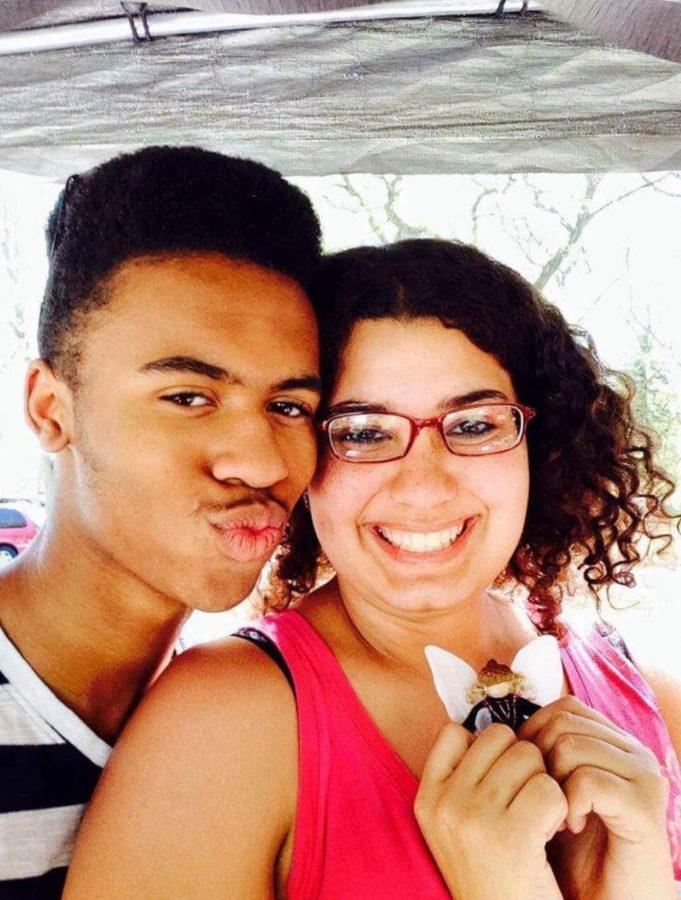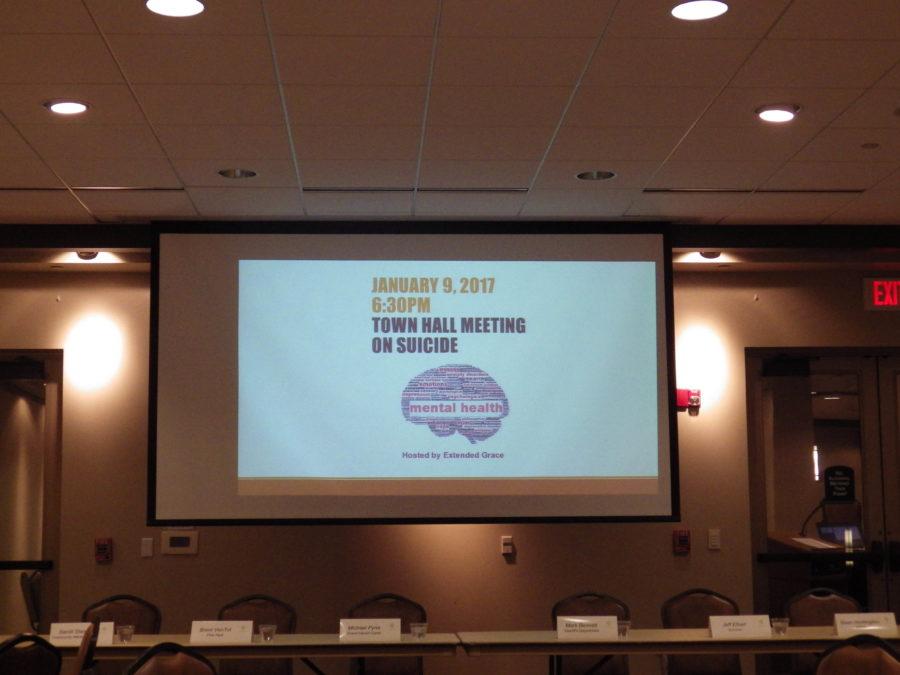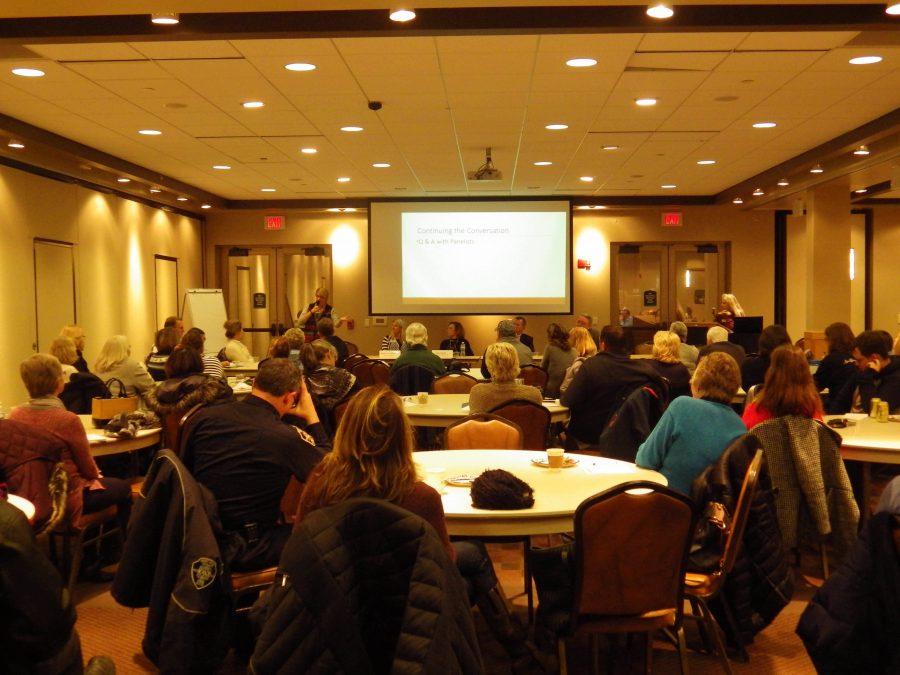Surviving suicide
Senior AJ Melton struggles to cope with friend's death
February 16, 2017
GIVING UP GABBY: Senior AJ Melton snaps a selfie with his friend Gabby. Gabby died by suicide in 2015. “Not having her here feels like there’s a missing piece of my heart,” Melton said.
After he read the text message, senior AJ Melton’s bird-like frame crumpled on the sidewalk in front of Jumpin’ Java Coffee House. His sobs sliced through the calm June air.
Memories of Melton’s friend Gabby flooded his mind.
He remembered splashing around with her in Lake Michigan. As she emerged from the water, his first thought was ‘She looks like a mermaid.’ He couldn’t tear his eyes away. Gabby’s hair was usually tucked away in a ponytail, but dark curls cascaded down her back. She looked unreal, like a creature from another planet.
He remembered listening to reggae music as they cartwheeled in the grass at her 17th birthday party, howling with laughter. He couldn’t get her smile out of his mind; an innocent grin that never held back. He wished he could see it now- but he couldn’t.
That text told him that she died from suicide.
“The day I found out was exam day, last day of school,” Melton said. “I found out that morning that she was in the hospital. I failed both of my exams that day because all I could think about was her.”
His friends were throwing an end of the year beach party downtown after school, so when the final bell rang, he boarded the Harbor Transit to Jumpin’ Java as he had originally planned. Unsure of what was happening at the hospital, Melton texted Gabby’s mom.
“Mom, what is this about her being in the hospital?” Melton asked. “What’s going on?”
“It’s true,” she replied.
“It’s true, what? That she’s in the hospital?”
“Yeah.”
“Oh OK, well is she doing alright?”
“No, she’s gone.”
“What do you mean, she’s gone?”
“I mean she passed away this morning.”
Melton’s friend Roxy Peoples watched him hit the ground.
“We were all meeting up when AJ got the text,” Peoples said. “He broke down immediately and started crying and shouting. I was really confused- I didn’t know what was happening. I felt this kind of sadness come down on the group.”
Luna Watkins, another friend of Melton’s, pushed through Jumpin’ Java’s glass doors. Shooting a quick glance at the three white dancing frogs painted on them, Watkins clutched her iced coffee and walked outside.
She didn’t expect to see a group huddled around Melton.
“I didn’t know what was going on, and I was really confused,” Watkins said. “AJ was crying, which was weird ‘cause I’d never seen him cry before.”
The wind whipped across Melton’s skin as the world began to bleed together. He was vaguely aware of fuzzy faces surrounding him, and, looking back, he wondered what the people driving past had thought. But at the time, Gabby was the only person on his mind.
The wind whipped across Melton’s skin as the world began to bleed together. He was vaguely aware of fuzzy faces surrounding him, and, looking back, he wondered what the people driving past had thought. But at the time, Gabby was the only person on his mind.
“Gabby was everything that I’d ever want to be,” Melton said. “Beautiful, inside and out. She did not think that she was attractive on the outside at all, but she was gorgeous. And I used to tell her all the time, I used to say ‘Every physical and nonphysical attribute that anyone would ever want, you have.’ I desperately wanted her to know that she was special and that she meant a lot to me and to other people.”
Curled up on the sidewalk, though, Melton was numb.
“At one point, my friends had to carry me because I couldn’t walk,” Melton said. “We still went to the beach, though. We got there and sat down, and then everything…you know those paintings, where everything isn’t clear and precise, but kind of fuzzy and blurry? That’s what it looked like.”
Melton didn’t have a ride home, so he laid down in the sand and stared at the sky. He didn’t trust himself enough to go swimming.
“I didn’t want to drown myself or kill myself in the water,” Melton said. “It was this weird subconscious thing, my subconscious was keeping me from doing the thing it knew would hurt me. People were cracking jokes, and I remember that they should’ve been funny, but I couldn’t laugh and I couldn’t smile. I couldn’t do anything, and anything that I did, I automatically knew that it wasn’t genuine, that I wasn’t feeling that genuine emotion. I was hurting.”
Limited licensed psychologist and psychotherapist Deb Spoors says that people who lose loved ones to suicide think about every recent encounter they had with the person and wonder if they could have done more. They often feel guilt, anger, resentment, remorse, confusion and distress over unresolved issues.
“In the beginning, there is a sense of disbelief that this is really happening,” Spoors said. “Soon, this disbelief turns to heart-wrenching grief. You can’t stop thinking about the permanence of ‘going away forever.’”
Each suicide intimately affects at least six other people. Friends and family that remain become known as “survivors.” Melton is one of these survivors.
“I blame myself for Gabby’s passing ‘cause I’m like, what else could I have done to save her?,” Melton said. “If only I would’ve texted her that night. If only I would’ve just said ‘Hi,’ if only I would’ve called her, if only I would’ve did this. It’s like shoulda coulda woulda, she’s gone. I can’t do that now.”
According to Spoors, teenagers form more intense connections to their peers than adults would. Since our brains aren’t fully developed until we’re 25, teens don’t have full capability to manage tragedy. Losing their friends or loved ones to suicide becomes a benchmark in their teenage development that is never forgotten.
The stigma surrounding suicide makes it even more difficult for teenage survivors to deal with their grief, which causes them to feel isolated. Survivors find that people relate differently to them after the suicide, and might be reluctant to talk about what has happened.
“AJ didn’t really share his super personal feelings with me on subjects that really upset him,” Watkins said. “It’s like it would happen and if you were around at that moment, you would see his true reaction but otherwise he felt the pain of those alone and he didn’t share it.”
Melton said that while Gabby, like him, always seemed happy, it was because she was happy for other people.
“Me and Gabby are a lot alike in that aspect,” Melton said. “The happiest people that you see are normally the ones hurting the most. One of the reasons I’m so loud and funny and all of that is because, for my enjoyment too, but at the same time, most of the time, I am ensuring that my friends are OK. If you aren’t happy throughout the day, but you get to come to lunch and hear somebody crack a joke that makes you laugh and then makes your day just a little bit brighter than it used to be, that’s good enough. Why should you be happy, and not want someone else to have that same happiness you have?”
Suicide is the third leading cause of death for 15 to 24-year-olds and the sixth leading cause of death for five to-14-year-olds. On average, for each suicide, there are 25 attempts.
“We were all there for Gabby, but at the same time, there was a lot of people that talked about her, called her weird. The things that I’ve heard said about her are appalling,” Melton said. Curious eyes peer in his direction, but his voice grows louder. “And then for people to turn around when she passes and be like, ‘Oh, I knew her, she was so amazing’ and I think, if you think that a person is so amazing while they are alive, tell them, because if they don’t feel amazing, then they’ll hear all of how amazing they were after they’re gone, and then after they’re gone, it’s too late for them to come back, so then what the fuck can you do?”
It was past 7 p.m. as the waves began to darken and the sun slowly started to sink when Melton left the beach. The next thing he knew, he was climbing in his step-father Gerald’s navy blue Audi, and the longest 20 minutes of his life began. They drove to Mercy Hospital in silence.
“I had to see her,” Melton said. “It would be the only thing that made it real to me that she was gone.”
His usual strut was gone as he ambled through the blank, bland hospital halls. After he told the woman behind the desk who he was looking for, without hesitation he added, ‘I’m her brother.’
“I still felt like I was dreaming, even when I was looking at Gabby,” Melton said. “I was still waiting for it to be some sick joke. She was laying there and she was on life support because she said that before she died, she wanted to donate all of her organs. Even in death, she still wanted to take care of people. Somewhere, in someone else, the physical part of her is still living on. I knew she always wanted to help.”
For once, his voice got softer.
“I don’t- I don’t cry,” Melton said. “I’m not a crier, I don’t do that. But I cried. A lot. And really hard.”
Seven months later, Melton’s bird-like frame leans against a wall outside the cafeteria with his knees drawn up near his chin.
“Not having her here feels like there’s a missing piece of my heart,” Melton said. “To me, nothing ever truly dies. No one ever truly dies. If they were a living spirit here on this planet, then they will always live. I feel like she can still hear me and we can still hear her, feel her.”
School district takes “slow and steady path” in mental illness initiative
“I’ll start,” a woman across from me said after a moment of silence. She sat upright and rested her arms on the round table. “I’m here because, in 2014, my brother took his life.”
The man to my right, Wade VanBragt, stared at his phone as we talked. He forced himself to look up when it was his turn.
“I lost my daughter, a teen, last March,” he said. His voice wavered and his eyes watered, but his face remained composed. “Her name is Kylie. I never knew she had any type of depression. March 21st. She was doing her homework, said love you, closed her door. Next morning she was gone.”
He showed us the picture he was staring at. A seventh-grader in a white tee-shirt watched me from his iPhone. Her indistinguishable gray-blue eyes were fierce, but weary. Her lips, smooth with maroon matte lipstick, were opened slightly as if she wanted to say something, then changed her mind.
“She’s beautiful,” someone said.
“She didn’t think so,” VanBragt said. “From what I understand…I don’t even know why I’m here to be honest with you because there’s no answers.”
One by one, we went around the table and explained why we were attending the Jan. 9 Town Hall on Suicide. Since 2011, we’ve lost six students from 7th to 12th grade to death by suicide.
The Town Hall included two separate panels to discuss the problem and what’s being done to address mental illness in the community. The panel discussing what was being done included Beth Egge from the Depression and Bipolar Support Alliance (DBSA) National Office, Sarah Lewakowski from TCM Counseling, Principal Tracy Wilson, Spring Lake High School Principal Mike Gilchrist and David Neal from the North Ottawa Community Health (NOCH) Emergency Room.
The latest developments have been implemented by the school district.
“I knew that we would need to do something with a population of 2,000 at Grand Haven High School and 100 at Central High School immediately because, in the fall of 2015, we had just recently lost our second young lady, which was our third death by suicide since 2011,” Wilson said. “We felt it very important to do something immediately with high school staff and students. In the fall of 2015, we kicked off our initiative and we have taken the slow and steady path in Grand Haven because it’s been very critical to us that we have a systematic pre-k through 12 focus that is also something that’s going to be sustainable.”
This year, they initiated a pre-k through four Second Step Program and five through eight and nine through 12 Mindfulness curriculums. The 2016-2017 school improvement lessons are focused largely on mindfulness as well.
With a grant received from 100 Women Who Care, the district re-implemented the 90-minute “Live, Love, Laugh” for freshmen and are currently continuing to research a “sustainable program.”
Several committees and clubs dedicated to improving the school’s environment have also formed. A parent committee called “You Matter” has partnered with the Team GH Committee to bring conversations to parents.
“Along with our parents, with TCM and other local agencies, we are making progress,” Wilson said. “I get typically a few times a month, an email or phone call from a parent saying thank you for doing what you’re doing because you’re giving kids the information. I got a telephone call last night and ‘I took my son or my daughter to the ER to be evaluated because of something my son or daughter put on their Facebook or Twitter or Instagram.’ Our kids aren’t afraid now to give that information to a trusted adult.”
A student committee dealing with David Staal’s book “Show Up” was created. In Wilson’s words, its purpose is to say “put down electronics, look at each other, show up for someone else for a moment or longer, you have no idea if the moment you show up for somebody will actually change the trajectory of their life.” Students also formed the Do Random Acts of Kindness (DoRAK) Club.
“Schools can’t be masters at mental health and education,” VanBragt said. “I can’t put the burden on our schools to cure the disease, but the schools should provide a safe atmosphere for students to learn without bullying in any shape or form. Zero tolerance. If the schools can provide a safe atmosphere, that would be one less battlefront children like my daughter would have to endure.”
Jan. 9 Town Hall on Suicide updates community on state of mental health
Non-profit social lab Extended Grace hosted a Town Hall meeting on suicide on Monday, Jan. 9 at the Community Center. This was the fourth Town Hall on Mental Illness.
“Last year, the community was reeling from the budgetary cuts to Community Mental Health, as well as growing alarm regarding suicides among our young people,” Extended Grace Executive Director Barbara Lee said. “We decided a community forum to address concerns would be the best way to start getting our arms around the problem.”
After the first meeting, they created the Mental Illness Task Force. The second Town Hall was a follow-up to the first, reporting back on what they had accomplished and what their priorities were and asking the community if they were on track. The third dealt with the intersection of mental illness and the criminal justice system.
The Town Hall on Suicide went from 6:30-9 p.m. In addition to two separate panels there to name the problem and address what is being done in the community, the Town Hall Meeting included Q&A sessions with the panelists and a chance for people attending to discuss the topic with other community members.
Panelists there to name the problem included Sandi Stasko of Community Mental Health, Brent VanTol representing Pine Rest, Michael Pyne representing Grand Haven Cares, Captain Mark Bennett of the Ottawa Community Sheriff’s Department, Survivor Jess Elhart and Sean Huntington from the Depression and Bipolar Support Alliance (DBSA).
The second panel discussed what was being done to address mental health in the community. Speakers included Beth Egge from the DBSA National Office, Sarah Lewakowski from TCM Counseling, Principal Tracy Wilson, Spring Lake High School Principal Mike Gilchrist and David Neal from the North Ottawa Community Health (NOCH) Emergency Room.
“This is just such an important topic for this community to be talking about and I’ve often heard it said that we don’t talk about this, so I’m glad to provide an opportunity to do exactly that,” Lee said.


